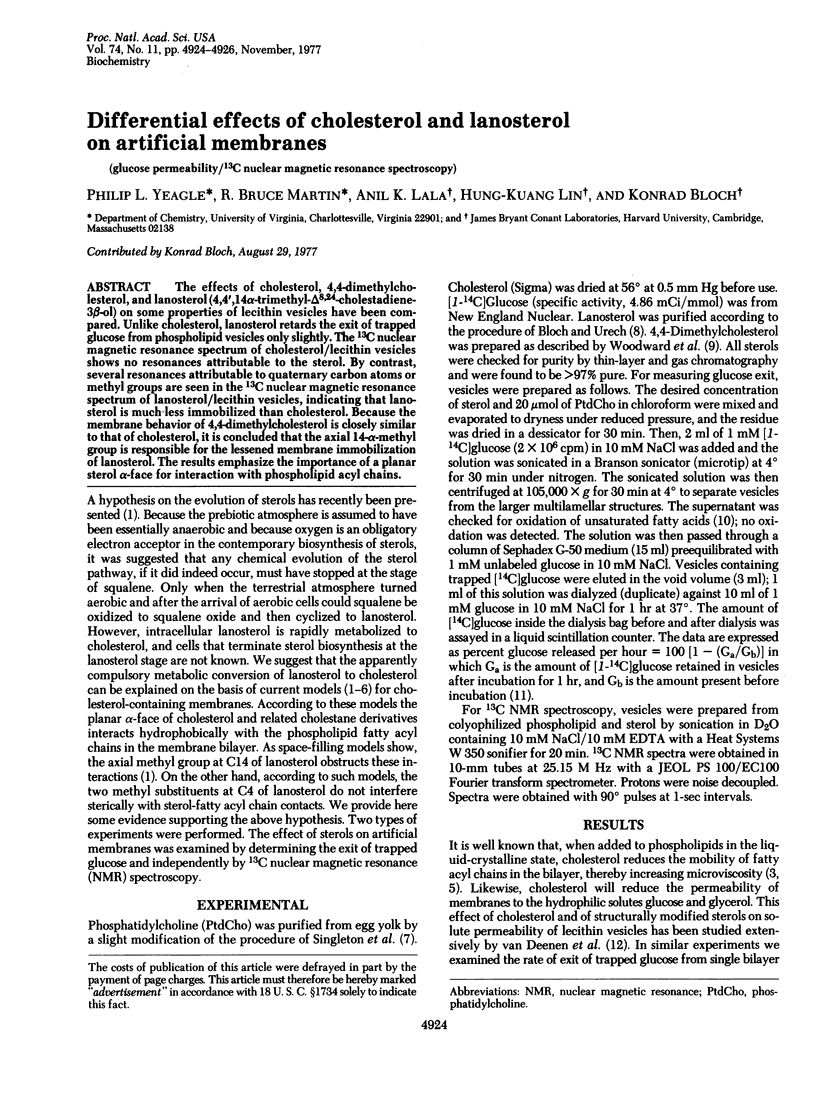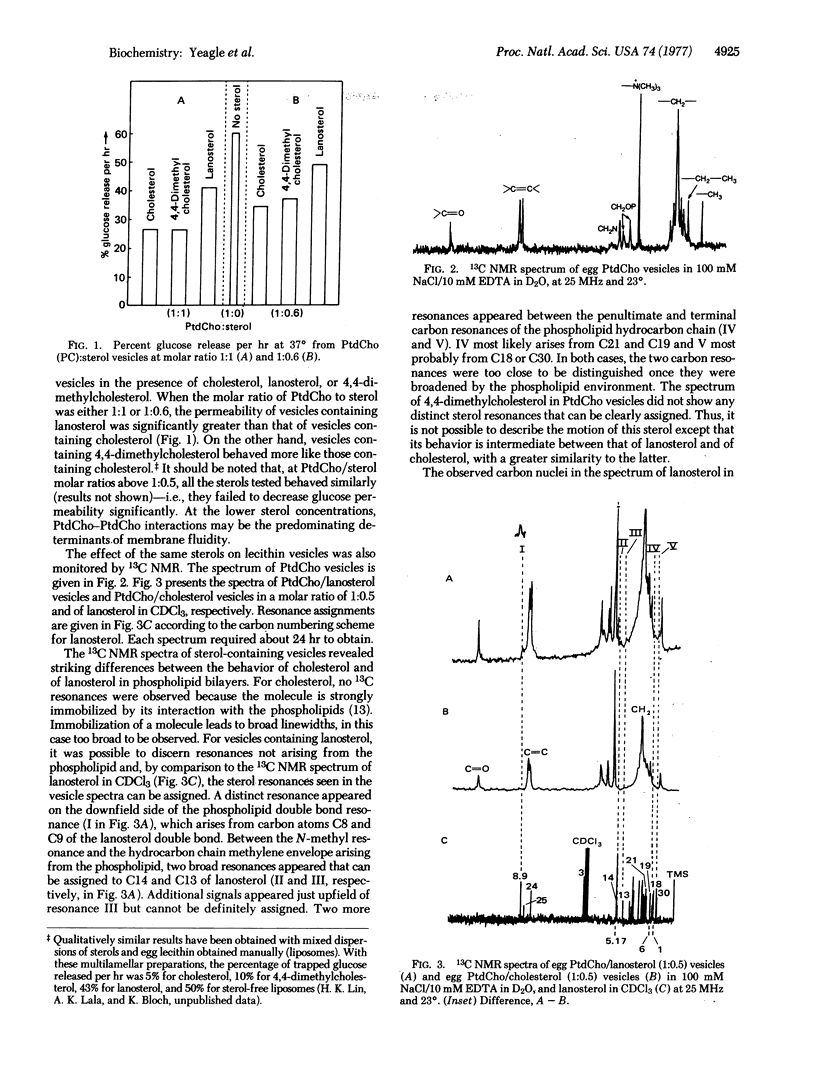Abstract
The effects of cholesterol, 4,4-dimethylcholesterol, and lanosterol (4,4',14alpha-trimethyl-delta8,24-cholestadiene-3beta-ol) on some properties of lecithin vesicles have been compared. Unlike cholesterol, lanosterol retards the exit of trapped glucose from phospholipid vesicles only slightly. The 13C nuclear magnetic resonance spectrum of cholesterol/lecithin vesicles shows no resonances attributable to the sterol. By contrast, several resonances attributable to quaternary carbon atoms or methyl groups are seen in the 13C nuclear magnetic resonance spectrum of lanosterol/lecithin vesicles, indicating that lanosterol is much less immobilized than cholesterol. Because the membrane behavior of 4,4-dimethylcholesterol is closely similar to that of cholesterol, it is concluded that the axial 14-alpha-methyl group is responsible for the lessened membrane immobilization of lanosterol. The results emphasize the importance of a planar sterol alpha-face for interaction with phospholipid acyl chains.
Full text
PDF


Selected References
These references are in PubMed. This may not be the complete list of references from this article.
- Bloch K. The biological synthesis of cholesterol. Science. 1965 Oct 1;150(3692):19–28. doi: 10.1126/science.150.3692.19. [DOI] [PubMed] [Google Scholar]
- Brockerhoff H. Model of interaction of polar lipids, cholesterol, and proteins in biological membranes. Lipids. 1974 Sep;9(9):645–650. doi: 10.1007/BF02532169. [DOI] [PubMed] [Google Scholar]
- CLARK A. J., BLOCK K. The absence of sterol synthesis in insects. J Biol Chem. 1959 Oct;234:2578–2582. [PubMed] [Google Scholar]
- Chang T. Y., Telakowski C., Heuvel W. V., Alberts A. W., Vagelos P. R. Isolation and partial characterization of a cholesterol-requiring mutant of Chinese hamster ovary cells. Proc Natl Acad Sci U S A. 1977 Mar;74(3):832–836. doi: 10.1073/pnas.74.3.832. [DOI] [PMC free article] [PubMed] [Google Scholar]
- Davis D. G., Inesi G., Gulik-Krzywicki T. Lipid molecular motion and enzyme activity in sarcoplasmic reticulum membrane. Biochemistry. 1976 Mar 23;15(6):1271–1276. doi: 10.1021/bi00651a016. [DOI] [PubMed] [Google Scholar]
- Demel R. A., Bruckdorfer K. R., van Deenen L. L. The effect of sterol structure on the permeability of lipomes to glucose, glycerol and Rb + . Biochim Biophys Acta. 1972 Jan 17;255(1):321–330. doi: 10.1016/0005-2736(72)90031-4. [DOI] [PubMed] [Google Scholar]
- Giraud F., Claret M., Garay R. Interactions of cholesterol with the Na pump in red blood cells. Nature. 1976 Dec 16;264(5587):646–648. doi: 10.1038/264646a0. [DOI] [PubMed] [Google Scholar]
- Hamilton J. A., Talkowski C., Childers R. F., Williams E., Allerhand A., Cordes E. H. Rotational and segmental motions in the lipids of human plasma lipoproteins. J Biol Chem. 1974 Aug 10;249(15):4872–4878. [PubMed] [Google Scholar]
- Huang C. H. Roles of carbonyl oxygens at the bilayer interface in phospholipid-sterol interaction. Nature. 1976 Jan 22;259(5540):242–244. doi: 10.1038/259242a0. [DOI] [PubMed] [Google Scholar]
- Klein R. A. The detection of oxidation in liposome preparations. Biochim Biophys Acta. 1970 Sep 8;210(3):486–489. doi: 10.1016/0005-2760(70)90046-9. [DOI] [PubMed] [Google Scholar]
- Kroon P. A., Kainosho M., Chan S. I. State of molecular motion of cholesterol in lecithin bilayers. Nature. 1975 Aug 14;256(5518):582–584. doi: 10.1038/256582a0. [DOI] [PubMed] [Google Scholar]
- Oldfield E., Chapman D. Dynamics of lipids in membranes: Heterogeneity and the role of cholesterol. FEBS Lett. 1972 Jul 1;23(3):285–297. doi: 10.1016/0014-5793(72)80300-4. [DOI] [PubMed] [Google Scholar]
- Overath P., Schairer H. U., Stoffel W. Correlation of in vivo and in vitro phase transitions of membrane lipids in Escherichia coli. Proc Natl Acad Sci U S A. 1970 Oct;67(2):606–612. doi: 10.1073/pnas.67.2.606. [DOI] [PMC free article] [PubMed] [Google Scholar]
- Papahadjopoulos D., Nir S., Oki S. Permeability properties of phospholipid membranes: effect of cholesterol and temperature. Biochim Biophys Acta. 1972 Jun 20;266(3):561–583. doi: 10.1016/0006-3002(72)90001-7. [DOI] [PubMed] [Google Scholar]
- Rothman J. E., Engelman D. M. Molecular mechanism for the interaction of phospholipid with cholesterol. Nat New Biol. 1972 May 10;237(71):42–44. doi: 10.1038/newbio237042a0. [DOI] [PubMed] [Google Scholar]
- SINGLETON W. S., GRAY M. S., BROWN M. L., WHITE J. L. CHROMATOGRAPHICALLY HOMOGENEOUS LECITHIN FROM EGG PHOSPHOLIPIDS. J Am Oil Chem Soc. 1965 Jan;42:53–56. doi: 10.1007/BF02558256. [DOI] [PubMed] [Google Scholar]
- Yeagle P. L., Hutton W. C., Huang C. H., Martin R. B. Headgroup conformation and lipid--cholesterol association in phosphatidylcholine vesicles: a 31P(1H) nuclear Overhauser effect study. Proc Natl Acad Sci U S A. 1975 Sep;72(9):3477–3481. doi: 10.1073/pnas.72.9.3477. [DOI] [PMC free article] [PubMed] [Google Scholar]
- Yeagle P. L., Hutton W. C., Huang C. H., Martin R. B. Structure in the polar head region of phospholipid bilayers: A 31P [1H] nuclear Overhauser effect study. Biochemistry. 1976 May 18;15(10):2121–2124. doi: 10.1021/bi00655a014. [DOI] [PubMed] [Google Scholar]
- de Kruyff B. Lipid-sterol interactions in liposomes and membranes. Biochem Soc Trans. 1975;3(5):618–621. doi: 10.1042/bst0030618. [DOI] [PubMed] [Google Scholar]


